History
Pre-Islamic Arabia was rich and glorious center of Vedic civilization
Published
4 years agoon
By
Vedic Tribe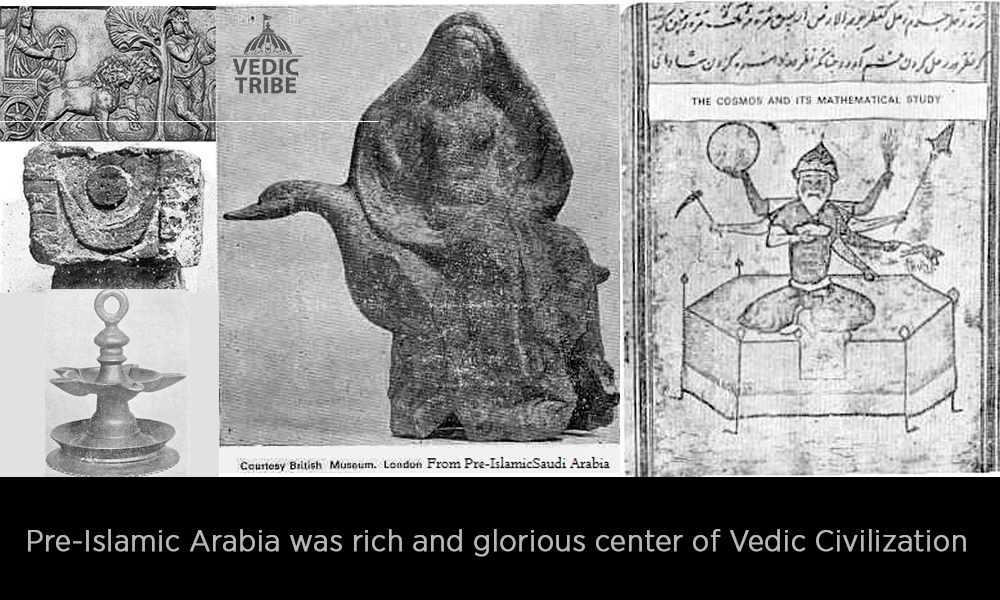
Many centuries before prophet Muhammad and the destructive advent of Islam, Arabia or Arabistan was an extremely rich and glorious center of Vedic civilization. In this article, I will prove to you point by point that pre-Islamic Arabia was in fact a flourishing civilization which revered Vedic culture.
It is the Muhammad and the followers of Islam who are fully responsible for the dissemination and destruction of this once glorious culture.
In learning about this most ancient heritage, let’s begin with the word Arabistan itself. Arabistan is derived from the original Sanskrit term Arvasthan which means The Land of Horses. Since time immemorial proponents of the Vedic culture used to breed exceptional horses in this region. Thus eventually the land itself began to be called Arva (Horses) –Sthan(place). The people who lived in this land were called Semitic. Semitic comes from the Sanskrit word Smritic. Arabs followed the ancient Vedic Smritis such as Manu-Smriti as their revered religious guides and thus they were identified as Smritic which has been corrupted into Semitic.
At that time the Uttarapath (Northern Highway) was the international highway to the North of India. It was via Uttarapath that Arabia and other Middle Eastern countries drew their spiritual, educational and material sustenance from India. Besides, this Sea-links were formed with India at least 800 years before the advent of Islam. Basra was the ancient gateway to India because it was at this port that the Arab lands recieved Indian goods and visitors. At that time the spoken language was Sanskrit, which later dwindled into the local variation that we now call Arabic. The proof of this is that thousands of words that were derived from Sanskrit still survive in Arabic today.
Here is a sampling of some:
| Sanskrit | Arabic | English |
| Sagwan | Saj | Teakwood |
| Vish | Besh | Poison |
| Anusari | Ansari | Follower |
| Shishya | Sheikh | Disciple |
| Mrityu | Mout | Death |
| Pra-Ga-ambar | Paigambar | One from heaven |
| Maleen | Malaun | Dirty or soiled |
| Aapati | Aafat | Misfortune |
| Karpas | Kaifas | Cotton |
| Karpur | Kafur | Camphor |
| Pramukh | Barmak | Chief |
Even various kinds of swords were referred to as Handuwani, Hindi, Saif-Ul-Hind, Muhannid and Hinduani. The Sanskrit Astronomical treatise Brahma-Sphuta-Siddhanta in Arabic translation is known as Sind-Hind, while another treatise Khanda-Khadyaka was called Arkand. Mathematics itself was calledHindisa .
The Arabs derived technical guidance in every branch of study such as astronomy, mathematics and physics from India. A noted scholar of history, W.H. Siddiqui notes:
“The Arab civilization grew up intensively as well as extensively on the riches of Indian trade and commerce. Nomadic Arab tribes became partially settled communities and some of them lived within walled towns practised agriculture and commerce, wroteon wood and stone, feared the gods and honored the kings.”
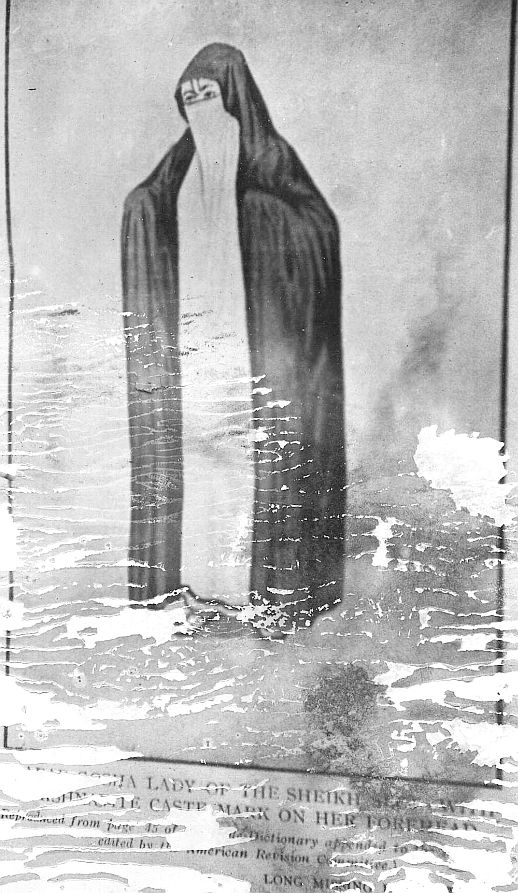
Photo above shows an Arab sheikh’s wife in gosha/veil having a U-shaped vermilion mark on her forehead.
Some people wrongly believe that Arabs used the word Hindu as a term of contemptuous abuse. Nothing could be further from the truth. The people of pre-Islamic Arabia held Hinduism in great esteem as evidenced from the fact that they would endearingly call their most attractive and favourite daughters as Hinda and Saifi Hindi. The fact that Arabs regarded India as their spiritual and cultural motherland long before the damaging influence of Islam is corroborated by the following poem which mentions each one of the four Vedas by name: (The English translation is in black)
“Aya muwarekal araj yushaiya noha minar HIND-e
Wa aradakallaha manyonaifail jikaratun”
“Oh the divine land of HIND (India) (how) very blessed art thou!
Because thou art the chosen of God blessed with knowledge”
“Wahalatijali Yatun ainana sahabi akha-atun jikra Wahajayhi yonajjalur
-rasu minal HINDATUN “
“That celestial knowledge which like four lighthouses shone in such
brilliance – through the (utterances of) Indian sages in fourfold abundance.”
“Yakuloonallaha ya ahal araf alameen kullahum
Fattabe-u jikaratul VEDA bukkun malam yonajjaylatun”
“God enjoins on all humans, follow with hands down
The path the Vedas with his divine precept lay down.”
“Wahowa alamus SAMA wal YAJUR minallahay Tanajeelan
Fa-e-noma ya akhigo mutiabay-an Yobassheriyona jatun”
“Bursting with (Divine) knowledge are SAM &YAJUR bestowed on creation,
Hence brothers respect and follow the Vedas, guides to salvation”
“Wa-isa nain huma RIG ATHAR nasayhin Ka-a-Khuwatun
Wa asant Ala-udan wabowa masha -e-ratun”
“Two others, the Rig and Athar teach us
fraternity, Sheltering under their lustre dispels darkness till eternity”
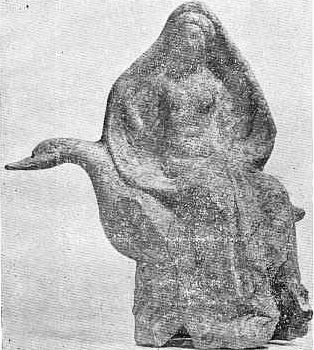
This idol was found in arabia and dates back to pre-islamic days in that region. This is now displayed in British Museum.
This poem was written by Labi-Bin-E- Akhtab-Bin-E-Turfa who lived in Arabia around 1850 B.C. That was 2300 years before Mohammed!!! This verse can be found in Sair- Ul-Okul which is an anthology of ancient Arabic poetry. It was compiled in 1742 AD under order of the Turkish Sultan Salim.
That the Vedas were the religious scriptures to which the Arabs owed allegiance as early as 1800 B.C. proves not only the antiquity of the Vedas but also the existence of Indian rule over the entire region from the Indus to the Mediterranean, because it is a fact of history that the religion of the ruler is practised by his subjects.
Vedic culture was very much alive just before the birth of Muhammad. Again let’s refer to the Sair-Ul-Okul. The following poem was written by JirrhamBintoi who lived 165 years before the prophet Muhammed. It is in praise of India’s great King Vikramaditya who had lived 500 years before Bintoi. (The English translation is in red).
“Itrasshaphai Santul
Bikramatul phehalameen Karimun
Bihillahaya Samiminela
Motakabbenaran Bihillaha
Yubee qaid min howa
Yaphakharu phajgal asari
nahans Osirim Bayjayholeen
Yaha sabdunya Kanateph natephi
bijihalin Atadari Bilala masaurateen
phakef Tasabahu. Kaunni eja majakaralhada
walhada Achimiman, burukan, Kad, Toluho
watastaru Bihillaha yakajibainana
baleykulle amarena
Phaheya jaunabil amaray Bikramatoon”
– (Sair-ul-Okul, Page 315)
“Fortunate are those who were born
during King Vikram’s reign, he was
a noble generous, dutiful ruler devoted
to the welfare of his subjects. But at
that time, We Arabs oblivious of divinity
were lost in sensual pleasures. Plotting
& torture were rampant. The darkness of
ignorance had enveloped our country.
Like the lamb struggling for its life
in the cruel jaws of a wolf, we Arabs
were gripped by ignorance. The whole
country was enveloped in a darkness as
intense as on a New moon night. But the
present dawn & pleasant sunshine of
education is the result of the favor of
that noble king Vikram whose benevolence
did not lose sight of us foreigners as we
were. He spread his sacred culture amongst
us and sent scholars from his own land
whose brilliance shone like that of the sun
in our country. These scholars & preceptors
through whose benevolence we were once again
made aware of the presence of god, introduced
to his secret knowledge & put on the road to
truth, had come to our country to initiate us
in that culture & impart education.”
Thus we can see that Vedic religion and culture were present in Pre-Islamic Arabia as early as 1850 B.C., and definitely present at the time of Mohammed’s birth.
In his book Origines, Volumes 3 & 4″, Sir W. Drummond adds:
“Tsabaism was the universal language of mankind when Abraham received his call, their doctrines were probably extended all over the civilized nations of Earth.”
Tsabaism is merely the corruption of the word Shaivism which is Vedic religion. On page 439 of this book, Sir Drummond mentions some of gods of pre-Islamic Arabs, all of which were included in the 360 idols that were consecrated in the Kaba shrine before it was raided and destroyed by Muhammad and his followers. Here are some of the Vedic deities and their original Sanskrit names:
| Arabic | Sanskrit | English |
| Al-Dsaizan | Shani | Saturn |
| Al-Ozi or Ozza | Oorja | Divine energy |
| Al-Sharak | Shukra | Venus |
| Auds | Uddhav | – |
| Bag | Bhagwan | God |
| Bajar | Vajra | Indra’s thunderbolt |
| Kabar | Kuber | God of wealth |
| Dar | Indra | King of gods |
| Dua Shara | Deveshwar | Lord of the gods |
| Habal | Bahubali | Lord of strength |
| Madan | Madan | God of love |
| Manaph | Manu | First Man |
| Manat | Somnath | Lord Shiv |
| Obodes | Bhoodev | Earth |
| Razeah | Rajesh | King of kings |
| Saad | Siddhi | God of Luck |
| Sair | Shree | Goddess of wealth |
| Sakiah | Shakrah | Indra |
| Sawara | Shiva-Eshwar | God Shiva |
| Yauk | Yaksha | Divine being |
| Wad | Budh | Mercury |
The Kaba temple which was misappropriated and captured by Muslims was originally an International Vedic Shrine. The ancient Vedic scriptureHarihareswar Mahatmya mentions that Lord Vishnu’s footprints are consecrated in Mecca. An important clue to this fact is that Muslims call this holy precint Haram which is a deviation of the Sanskrit term Hariyam, i.e. the precint of Lord Hari alias Lord Vishnu. The relevant stanza reads: “Ekam Padam Gayayantu MAKKAYAANTU Dwitiyakam Tritiyam Sthapitam Divyam Muktyai Shuklasya Sannidhau” The allusion is to the Vamana incarnation of Lord Vishnu whose blessed feet were consecrated at three holy sites, namely Gaya, Mecca and Shukla Teertha. Worshipping such carved, holy foot impressions is a holy Vedic custom which convert Muslims are inadvertently perpetuating. But in doing this they delude themselves and mislead others that these foot-impressions which are on reverential display in several mosques and tombs around the world are in fact Muhammad’s own.
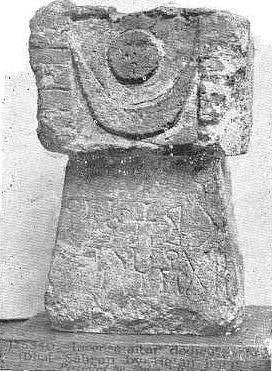
British Museum, London, has this inscription tablet from pre-Islamic Arabia. The crescent and sun on top relate to the Vedic dictum “Yawachchandra Diwakarau,” which signifies that the gift mentioned in the inscription should last as long as the sun and moon. This crescent and sun is a Vedic symbol, which still can be seen in use on the flags which adorn the top of the temple of Lord Jagannatha in Jagannatha Puri, as well as on coins in Hindu Nepal.
This symbol is in reference to the idea that it is Lord Vishnu who is the source of the light for the sun and the moon.
There are several snags in this argument. Firstly worshipping a foot -impression amounts to idolatry and should therefore be taboo for a true Muslim. Secondly Muhhamad disclaimed having performed any miracles. Therefore there can be no foot-impression of his on stone. Thirdly foot-impressions must always be in pairs like shoes. Yet in most of these shrines, it is usually a single footprint which suggests that Muhammad walked on only one foot. Another question that crops up is whether the foot-impression is of the same size and foot in all the shrines. The fact appears to be that when the Vedic Kaba shrine in Mecca was invaded by Muhammad, the pairs of foot impressions of Vedic deities there were plundered and later traded to the gullible and devout as Muhammad’s own footprints for some favour, reward or personal gain by unscrupulous muslims.
That is why they are single and not in pairs. The Black Stone which is the Shiv Emblem (also known as Sange Aswadwhich is a corrupted form of the Sanskrit word Sanghey Ashweta–meaningnon-white stone) still survives in the Kaba as the central object of Islamic veneration. All other Vedic Idols could be found buried in the precincts or trampled underfoot in labyrinthine subterranean corridors if archaeological excavations are undertaken.
The Black Stone has been badly mutilated, its carved base has disappeared and the stone itself is broken at seven places. It’s parts are now held together by a silver band studded with silver nails. It lies half buried in the South Eastern portion of the Kaba Wall (Refer to Figure 1). The term Kaba itself is a corruption of the Sanskrit word Gabha (Garbha + Graha) which means Sanctum. In addition, in the inscriptions from Hajja and its neighborhood was found a votive vessel dedicated by members of two tribes called Rama and Somia.Rama and Soma are Vedic deities, Rama is of the Solar dynasty and Soma is of the Lunar Dynasty. The moon god was called by various names in pre-Islamic times , one of them was Allah. Allah had 3 children, Al-Lat, Al-Uzzaand Manat. Al-Lat and Al-Uzza were both feminine deities. Alla is another name for the Hindu goddess Durga. It is obvious that the goddess Al-Lat was Alla (Durga) and Al-Uzza was Oorja (energy or life force also known asShakti). Manat was none other than Somnath which is another name for Lord Shiva. One significant point to note that Soma in Sanskrit means Moon andNath means Lord. Thus the Kaba itself was dedicated to the Moon GodSomnath alias Shiv and the word Somnath was corrupted to Manat.
The famous Black Stone is none other than the ShivLing of Makkeshwar alias Mecca. Lord Shiva is always shown with a crescent Moon on his head and every Shiva temple is supposed to have a sacred water spring representing theGanges. The Crescent Moon pinnacle of the Kaba and the Zamzam spring (actually Zamza from Ganga) are irrefutable testaments to the Vedic origins of the Kaba. Muslims from all over the world pay homage to Maqam-E-Ibrahim . This shrine is actually the pedestal of Brahma. Notice that the word, Ibrahim is actually a corruption of the word, Brahma. The octogonal grill which is a Vedic design, protects the holy footprints which represent the start of the creation nearly 2000 million years ago. Before it was captured by the Muslims it was an international shrine of the Vedic trinity. Muslims from all over the world pay homage to this shrine.
This shrine is actually the pedestal of Brahma. Notice that the word, Ibrahim is actually a corruption of the word, Brahma. The octogonal grill which is a Vedic design, protects the holy footprints which represent the start of the creation nearly 2000 million years ago. Before it was captured by the Muslims it was an international shrine of the Vedic trinity. In fact the names of the holiest of Muslim cities Mecca and Medina come from the Sanskrit words Makha-Medini which means the land of Fire-Worship. Even the most ancient names of these 2 cities were Mahcorava– which came from Mahadeva (Lord Shiva) and Yathrabn – which came fromYatra-Sthan (place of pilgrimage).
Islam came into being about 1372 years ago. It is well known that over 7500 years ago, at the time of the Mahabharat War, Kurus ruled the world. The scions of that family administered the different regions. Prophet Muhammed himself and his family were adherents of Vedic culture. The Encyclopedia Islamia admits as much when it says: “Muhammed’s grandfather and uncles were hereditary priests of the Kaba temple which housed 360 idols!” According to Arab traditions, Muhammad is a title. We do not know what name his parents had given him. We do however know that the central object of worship which survives at the Kaba today is a Shivling. That was allowed to remain there because that was the faceless family deity of Muhammad’s family. One of the original names of Lord Shiv is Mahadev (The Great God) therefore it is entirely possible Muhammad came from Mahadev. This appears fairly certain because the Arabs still have a Mahadevi sect. Moreover the titleMehdi of a Muslim chief is also a malpronounciation of the term Mahadeva.
According to Sanskrit etymology the term Muhammad implies ‘a person of great inspiration’ – ‘Mahan Madah yasya assau Muhammadah’ In a hostile sense it also implies ‘a person of a proud and haughty temperament’. The Qurayshi tribe into which Mohammed was born was particularly devoted to Allah and and the three children of the Moon God. Therefore when Muhammad decided to create his own Divine religion, he took innumerable aspects of the daily Vedic culture that surrounded him and corrupted them to suit his needs. It was with the advent of the Prophet and Islam that the death-knell of the glorious Arab culture was sounded. With Islam came the flood of destruction, murder, plunder and crime that destroyed the great Vedic heritage of Arabs.
The Prophet merely took some existing artefacts and terms and corrupted them so profoundly that no one would be able to discover their actual origins.In 570 AD, the year of Muhammad’s birth, Arabia was a thriving, rich and varied Vedic culture. Although monotheism in the forms of Christianity and Judaism were known to the people of Arvasthan, they were undeterred in their uncompromising faith to the religion of their ancestors: Hinduism . Every household had an idol of a Hindu god or goddess. There were hundreds of sacred groves, places of pilgrimage, and temples which were sanctuaries containing images of the entire range of Vedic gods. The temples in addition to being the religious focus of the Arabs, were also the cultural centres of learning. It was the temples that were the venues of literary and poetry competitions, of glorious festivals. The virtues most highly prized by people of Arvasthan were bravery in battle, patience in misfortune, loyalty to one’s tribe, and generosity to the needy and the poor. They proudly upheld the value of tolerance in matters of religious practice and belief.
The respect they showed towards other people’s religions was fully in keeping with their Vedic spiritual tradition. The status of women was that of pride and equal respect. How could it be otherwise with a people whose chief deity was the goddess Durga (Alla). Women married men of their choice and were financially independent. They were entrepeneurs, artisans, poets and even warriors! Later on Muhammad would marry Khadija, who was not only a wealthy merchant but also in the position to choose her own husband. This clearly demonstrates the level of freedom women enjoyed in Vedic Arabia. Hind, who was the wife of Muhammad’s chief enemy Abu Sufyan, herself participated in the battlefield. Hind opposed Muhammad tooth and nail. She followed her husband to the battlefield and when Abu Sufyan surrendered Mecca to Muhammad without a fight she caught hold of him in the marketplace and cried:
“KILL this fat greasy bladder of lard! What a rotten protector of the people”
When Muhammad tried to baptise her & asked her not to commit adultery , She spat out the bitter words: “A free woman does not commit adultery!” How proud this woman was of the rights and privileges that her Vedic society had invested to her! It was Islam that extinguished the light of knowledge in Vedic Arabia. It is ironic that the man who brought about such darkness himself belonged to the Qurayshi Tribe of Mecca. The Qurayshi were particularly devoted to Allah (Durga) and the famous Shivling of the Kaaba Temple. The fact that the Shivling remains to this day in the Kaaba is solely due to the fact that it happened to be the Qurayshi tribe’s faceless Family Deity.
As I mentioned before Muhammad’s name itself came from Mahadeva, which is another cognate for Lord Shiva. Muhammad’s own uncle, Umar-Bin-E-Hassham was a staunch Hindu and fervent devotee of Lord Shiva. He was a renowned poet and wrote many verses in praise of Shiva.
One of these has survived on page 235 of Sair-Ul-Okul and reads as follows: Kafavomal fikra min ulumin Tab asayru Kaluwan amataul Hawa was Tajakhru We Tajakhayroba udan Kalalwade-E Liboawa Walukayanay jatally, hay Yauma Tab asayru Wa Abalolha ajabu armeeman MAHADEVA Manojail ilamuddin minhum wa sayattaru Wa Sahabi Kay-yam feema-Kamil MINDAY Yauman Wa Yakulum no latabahan foeennak Tawjjaru Massayaray akhalakan hasanan Kullahum Najumum aja- at Summa gabul HINDU WHICH TRANSLATES AS: The man who may spend his life in sin and irreligion or waste it in lechery and wrath If at least he relent and return to righteousness can he be saved? If but once he worship Mahadeva with a pure heart, he will attain the ultimate in spirituality. Oh Lord Shiva exchange my entire life for but a day’s sojourn in India where one attains salvation. But one pilgrimage there secures for one all merit and company of the truly great.
Despite the fact that Muhammad had to destroy all traces of Hinduism in order to make his “new religion” work, he knew that in order to fool people convincingly he would have to borrow from the Vedic culture that surrounded him. Being illiterate he picked out rituals and symbols that he didn’t understand and distorted and falsified them for his own ends.
Here is a list of these distortions:
- Muhammad destroyed all 360 idols, but even he could not summon the courage to completely obliterate the Shivling in the Kaaba. He entered the temple and kissed the black stone. The Shivling was so sacred that the man who so detested idol- worship ended up kissing the largest idol in the Kaaba. Later his followers in a fit of piety broke the Shivling and then out of remorse repatched it together again. Today it lies broken at seven places and held together by a silver band studded with silver nails, bearing the name “Sangey Aswad” which came from the SanskritAshwet meaning non-white or black stone.
- He jumbled up the Sanskrit words Nama and Yaja (which meant “bowing and worshipping” respectively) into a combination wordNamaz and used that to describe his prescribed method of prayer.
- Because the Vedic custom was to pray facing the East, in his hatred for all things Hindu, he directed his followers to pray facing only the west.
- The method of circling around a shrine seven times in a clockwise direction is an ancient Vedic custom. Muhammad with his lack of originality decided that the 7 ritual perambulations should be retained but again in his hatred of all things Vedic decided the direction of the perambulations should be anti-clockwise.
- With his phobia of all things Vedic, Muhammad knew that the greatest reminder and threat to his forced brand of religion were the beautiful Vedic idols of Arabic temples. Thus he destroyed every idol he could find and made idol worship the greatest crime for a Muslim. Such a man could never have comprehended how an abstract concept can be conveyed through a symbolic representation in the form of an image. Thus he made all image representation a sin as well.
-
Vedic religion is known for its ancient oral tradition. It is well known that the Vedic culture emphasized oral debate and expression far more than the written word. In adition the oral recitation of Vedic scriptures was always done in a lyrical fashion, utilizing music and thus reaching a height of expression. In fear of this musical tradition Muhammad decided to forbid Music.
- All Arabic copies of the Koran have the mysterious figure 786 imprinted on them . No Arabic scholar has been able to determine the choice of this particular number as divine. It is an established fact that Muhammad was illiterate therefore it is obvious that he would not be able to differentiate numbers from letters. This “magical” number is none other than the Vedic holy letter “OM” written in Sanskrit (Refer to figure 2). Anyone who knows Sanskrit can try reading the symbol for “OM” backwards in the Arabic way and magically the numbers 786 will appear! Muslims in their ignorance simply do not realise that this special number is nothing more than the holiest of Vedic symbols misread.
There are many such instances where the symbols and rituals of Vedic culture were completely distorted and falsified by Muhammad in his bid to “create” his brand new religion. However in his haste to deceive and because of his ignorance and illiteracy, thousands of Vedic symbols still remain. Although they have been distorted beyond imagination, they still remain as solemn reminders of Arabia’s glorious Vedic past. They can never be suppressed.
In fact the rise of Islam put a full stop to all the previous knowledge of Arabia. The imperialistic message of Islam diverted all energies into raiding, looting and destruction. The incentive to learn and preserve the Vedic wisdom that had thrived in Arabia for so many centuries, was wiped out by the brutal pressure of Islam. Making easy money through loot and massacre was far more appealing than upholding the tenets of ancient knowledge. Gone were the schools, teachers, libraries, poets, artists, philosophers and scholars that had littered the Vedic landscape of Arabia like stars. Everyone had to become a raider if not from choice then for the sake of surviving the absolute intolerance of dissenters, that Islam preached. Thus was the light of learning extinguished in Arabia. All that remained was the Koran, the Kalma and the murderous hatred of anything Non-Muslim.
In my next article I will explore how the Arabs fought to keep the integrity and pride of their Vedic culture alive in the face of the violent, unjust and murderous destruction caused by the followers of Islam.
Note: Works of P.N. Oak, Sita Ram Goel, Arun Shourie, Jay Dubashi, Harsh Narain and Ram Swarup have been used to compose this article.
You may like
History
Snakes and Ladders, Originated in Ancient India called Mokshapat or Moksha Patamu
Published
4 years agoon
January 21, 2021By
Vedic Tribe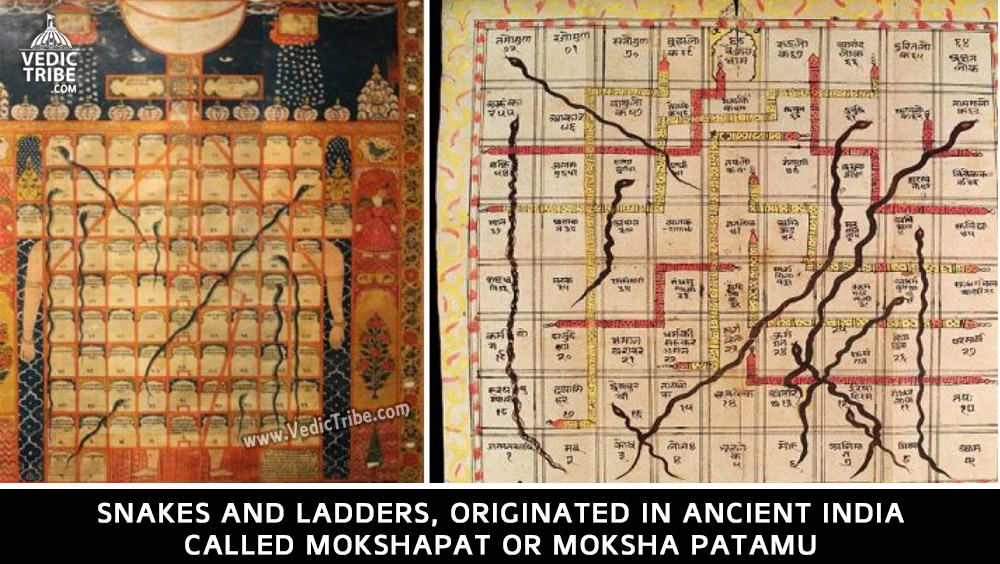
The board game, today called Snakes and Ladders, originated in ancient India, where it was known with the name Mokshapat or Moksha Patamu.
It’s not exactly known when or who invented it, though it’s believed the game was played at a time as early as 2nd century BC. According to some historians, the game was invented by Saint Gyandev.
Originally, the game was used as a part of moral instruction to children. The squares in which ladders start were each supposed to stand for a virtue, and those housing the head of a snake were supposed to stand for an evil. The snakes outnumbered the ladders in the original Hindu game. The game was transported to England by the colonial rulers in the latter part of the 19th century, with some modifications.
Through its several modifications over the decades, however, the meaning of the game has remained the same — ‘that good deeds will take people to heaven (Moksha) while evil deeds will lead to a cycle of rebirths in lower form of life (Patamu).
The modified game was named Snakes and Ladders and stripped of its moral and religious aspects and the number of ladders and snakes were equalized. In 1943, the game was introduced in the US under the name Chutes and Ladders.
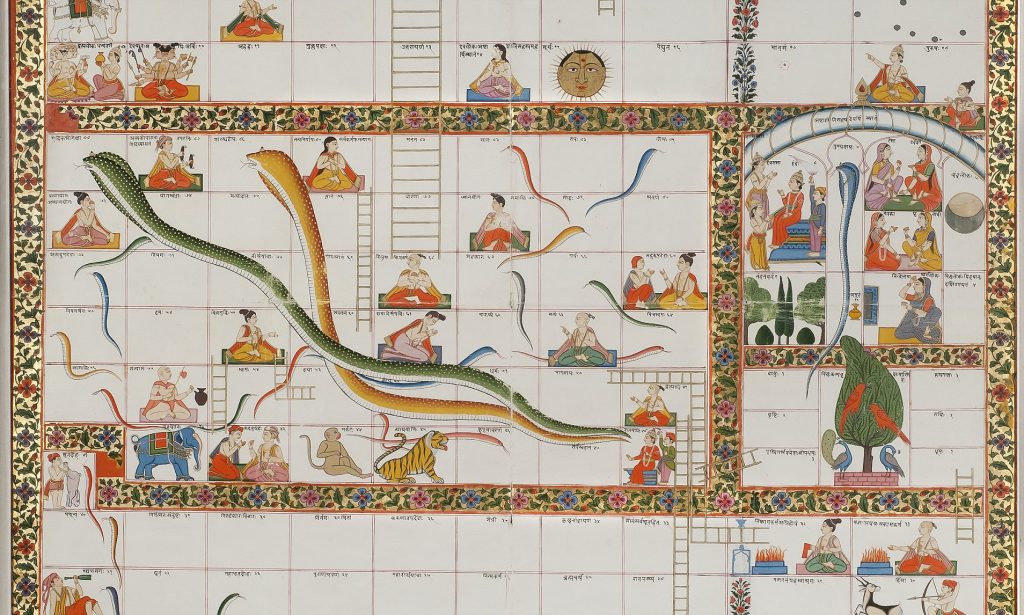
The Game of Knowledge
Originally, the game of Snakes and Ladders was known variously as Gyan Chaupar (meaning ‘Game of Knowledge), Mokshapat, and Moksha Patamu, and was originally a Hindu game. Nobody knows for sure as to who invented this game, or when it was created.
It may be said that whilst the gameplay of Gyan Chaupar is the same as today’s Snakes and Ladders, the board and higher objective of the game may be said to be quite different. Like the modern Snakes and Ladders board, the number of squares in that of Gyan Chaupar may vary. One version of this board, for instance, contains 72 squares, whilst another has 100. A major difference between the traditional and modern versions is the fact that in the former, a virtue or a vice and the effects of these virtues and vices, or something neutral is placed within each box.
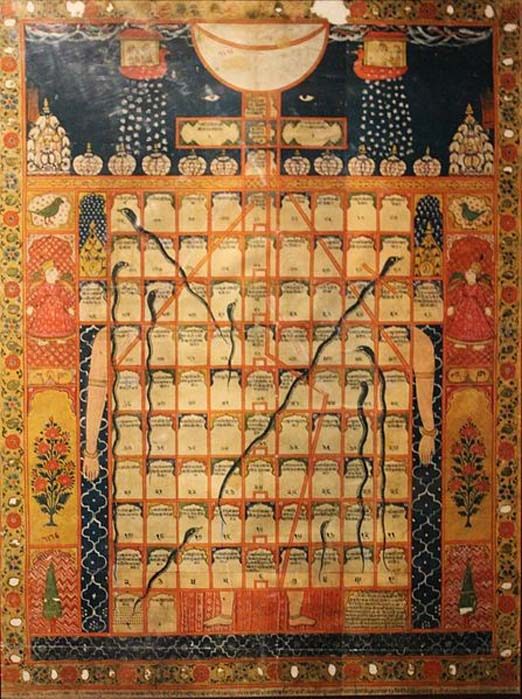
For instance, in an Indian Gyan Chaupar board of 72 boxes, squares number 24, 44, and 55 have the vices of bad company, false knowledge, and ego respectively. As the game places great emphasis on karma, the Hindu principle of cause and effect, each vice (the snakes’ heads) has a corresponding effect. Thus, for the vices mentioned above, the corresponding effects are conceit or vanity, plane of sensuality, and illusion. On the other hand, the virtues of purification, true faith, and conscience are contained in squares number 10, 28, and 46, and these lead to heavenly plane, plane of truth, and happiness respectively. In this version of the board, the goal is to reach box number 68, which is the plane of Shiva.
Religious Teaching Tool
This game was so popular that it was also adopted and adapted by other religions that existed in the Indian subcontinent. It is known that Jain, Buddhist, and Muslim adaptations of the game exist, as the concepts of cause and effect, and reward and punishment, are common to them. For devout followers of these religions, the game may be played as a form of meditation, as a communal exercise, and even as part of one’s religious studies without the use of more conventional books or sermons.
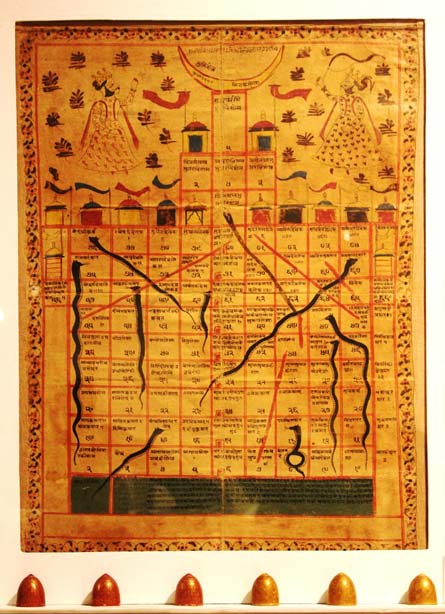
It may be added that many of the surviving game boards are works of art in their own right, as they contain elaborate illustrations of human figures, architecture, flora and fauna, etc. These boards were commonly made of painted cloth, and most of the extant ones date from after the middle of the18th century AD.
The Modern Game
The game of Gyan Chaupar became Snakes and Ladders towards the end of the 19 th century, when it was introduced to Great Britain by India’s colonial rulers. Whilst the original gameplay was maintained, its underlying philosophical message was greatly diminished. The religious virtues and vices were replaced by two-part cartoon dramas connected either by a snake or a ladder. Additionally, the number of snakes and ladders were equalized, whilst in the original ones, there were usually more snakes than ladders, which symbolizes the belief that it is far easier to fall prey to vice than to uphold virtue. From Great Britain, the game traveled to the United States, where it was introduced in 1943 by Milton Bradley as Chutes and Ladders.
Bharat
Telhara University – Older than Nalanda, Vikramshila Universities
Published
4 years agoon
December 29, 2020By
Vedic Tribe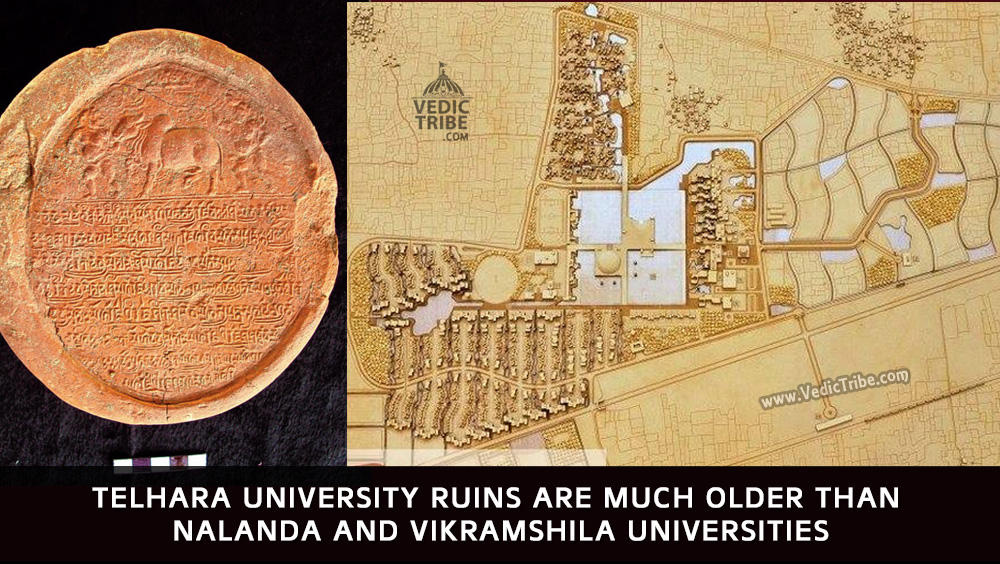
It was a useful mound, no doubt. A good vantage point where villagers occasionally relieved themselves.
But who would have thought that deep beneath its golden brown earth would be stories of dynasties and empires that now suggest that this — Telhara, a village 33 km from the ruins of the more famous Nalanda University — could be ‘Tilas-akiya’ or ‘Tiladhak’, the place Chinese traveler Hiuen Tsang visited and wrote about during his travels through India in 7th century AD? So far, there were only vague references but recent excavations at the mound suggest that Telhara was indeed an ancient university or seat of learning with seven monasteries.
The Bihar government has been calling the Telhara project one of its biggest after the excavations that unearthed Nalanda and Vikramshila universities. The excavation at Telhara should have happened earlier, say experts, but the site lost out to the more famous Nalanda.
The Telhara project that started on December 26, 2009, has so far come across over 1,000 priceless finds from 30-odd trenches — seals and sealing, red sandstone, black stone or blue basalt statues of Buddha and several Hindu deities, miniature bronze and terracotta stupas and statues and figurines that go back to the Gupta (320-550 AD) and Pala (750-1174 AD) empires. But the 2.6-acre mound has now thrown up the most tantalising find yet — evidence of a three-storied structure, prayer hall and a platform to seat over 1,000 monks or students of Mahayana Buddhism.
The terracotta monastery seals — a chakra flanked by two deers — unearthed at Telhara are similar to those at Nalanda, suggesting Telhara or Tiladhak was another great seat of learning besides Nalanda and Odantpuri during the Gupta and Pala reigns. It was the discovery of a similar monastery seal that clinched it for Nalanda University.
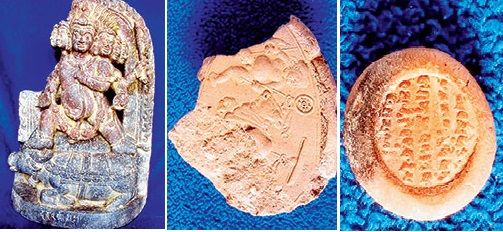
Former Archaeological Survey of India director B S Verma, who between 1971 and ’81 supervised the excavation at the site of the ancient Vikramshila university, says, “Telhara or Tiladhak has much more convincing epigraphical proofs — monastery inscriptions — than Vikramshila. The findings that match Hiuen Tsang’s account do more to convince that the place was a university or mahavihara similar to Nalanda.”
In his book, The Antiquarian Remains in Bihar, historian D R Patil writes about Hiuen Tsang’s description of Telhara. “Hiuen Tsang describes Telhara or Tilas-akiya as containing a number of monasteries or viharas, about seven in number, accommodating about 1,000 monks studying in Mahayan. These buildings, he says, had courtyards, three-storied pavilions, towers, gates and were crowned by cupolas with hanging bells. The doors and windows, pillars and beams have bas relieves (sculptures in guilded copper). In the middle vihara is a statue of Tara Bodhisatva and to the right (is) one of Avlokiteshwar”.
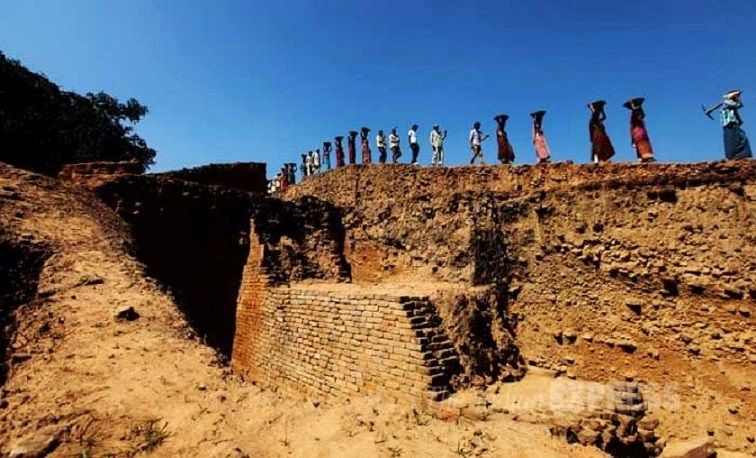
Other history books too talk of Tiladhak monastery, on the western side of Nalanda, as having four big halls and three staircases. It is said the mahavihara or university was built by one of the descendants of Magadha ruler Bimbisara. The monastery was decorated with copper and also had small copper bells that gently chimed in the breeze.
For months now, the excavation has been unearthing these stories. Apart from the mound that is now being dug up, Telhara has six other mounds — five of which have settlements and one which is partially elevated.
Atul Kumar Verma, director (archaeology) of the Bihar government’s Department of Art and Culture, says, “Since the excavations suggest that Telhara might have been a contemporary of Nalanda, it is quite possible that it was either an independent university for specialized education or that students graduating from Nalanda University would come here for specialized study. It is a great feeling to see the place emerging as the next big find after Nalanda. It has also aroused great curiosity and attracted even the likes of Nobel laureate Amartya Sen.” Sen wrote in the visitors’ book: “What a wonderful site, really thrilling! And so skillfully excavated and restored.”
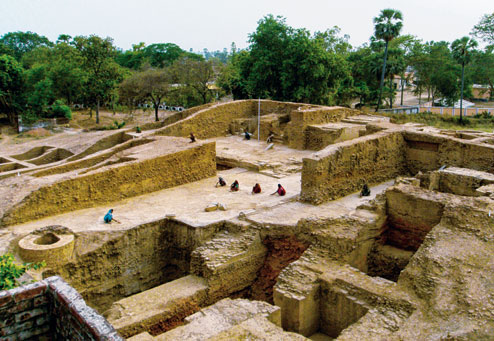
“We have found the courtyard that might have been an extension of the platform Hiuen Tsang had described,” Nand Gopal, camp in-charge at the Telhara site, says, peering into his optical line meter that’s mounted on a tripod.
In more recent times, it was A M Broadley, then magistrate of Nalanda, who in 1872 wrote about “Tilas-akiya” as a university and site of learning. British army officer and archaeologist Sir Alexander Cunningham, who visited the place between 1872 and 1878, wrote about inscriptions describing “Teliyadhak” as a place that had seven monasteries and which matched Hiuen Tsang’s account. A statue of the 12-armed Avlokiteshwar Buddha found from a Tiladhak site is at the Indian Museum in Kolkata. Perhaps the best known Pala sculpture from Telhara is now in Rietberg Muzeum, Zurich.
Though there was this and more proof that Telhara could be sitting on a glorious past, it wasn’t until December 2009 that the excavations finally began. Telhara panchayat head Awadhesh Gupta claims to have been the one who got things started.
“We all knew Telhara was once a great seat of learning, but nobody did anything to prove it. In 1995, I approached the Congress government requesting that the place be excavated but got no assurance. When Bihar Chief Minister Nitish Kumar visited the site in 2007, I put up this demand once again. The villagers were not happy with me. They thought I should have demanded something more concrete than just the digging of a mound.”
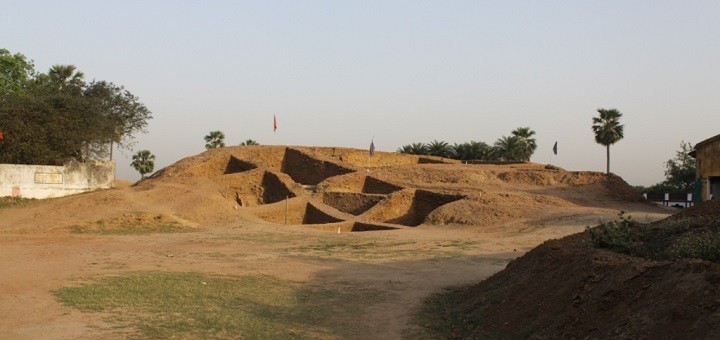
But the mukhiya may have had the last laugh. Villagers now talk about Telhara being part of the Nalanda-Rajgir circuit and how that could bring them jobs and better opportunities. “We hope the site is conserved and clubbed with Nalanda to attract tourists. The site has already given temporary jobs to 70 villagers,” says Anil Kumar, a villager.
It was a useful mound, no doubt.
Experts associated with its excavation are now claiming that the university originated in the Kushan period.
Atul Kumar Verma said that in the recent excavation, archaeologists have found some bricks of very large size (42x36x6.5cm) substantiating that the university belonged to the Kushan period. “Bricks of the Kushan period were quite large from other dynasties, including the Gupta and Pala periods,” said Verma.
While the Kushan period is considered to be 1st century AD, the Gupta dynasty ruled from 3rd to 6th century AD.
MAJOR FINDINGS
SEALS AND SEALING
The recovery of over 100 terracotta seals and sealings from the Gupta and Pala periods provides strong evidence of this being a Buddhist university. Besides seals of the chakra flanked by two deers, other seals have inscription of Buddhist mantras. Seals of Gaj-Lakshmi and flying birds were also found. Some inscriptions that have not yet been deciphered would be sent to Mysore for deciphering.
PLATFORM, TEMPLES
Just above the ashen layer — said to be proof of Turkish general Bakhtiyar Khilji having destroyed the monastery — is the sanctum sanctorum of three Buddhist shrines, each measuring 3.15 square metres. A big platform, found just below this ashen layer, is said to have accommodated over 1,000 monks.
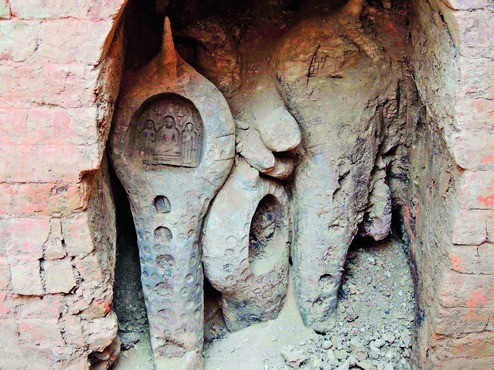
CELLS FOR TEACHERS
The excavation has so far revealed 11 cells of 4 square meters each. It is believed that these were faculty quarters. There is evidence of bricks from the Gupta and Pala periods.
COPPER BELL CHIMES
The excavation revealed several broken pieces of small bells. Parts of molten copper also suggest that the monastery was well-decorated.
CAUTION INSCRIPTION
A stone inscription in Sanskrit (early Nagari script), probably written just before the destruction of the Tiladhak mahavihara, says, “He who tries to destroy this monastery is either a donkey or a bull”. Below the stone inscription are images of the two animals.
FASTING BUDDHA AND VOTIVE STUPA
A miniature terracotta image of a fasting Buddha from the Pala period is a rare find. A six-foot-tall votive stupa from the Pala period suggests the prevalence of Buddhism.
MAURYAN PERIOD
Bone tools and pottery shards of Northern Black Polished Ware points to this being a settlement in the Mauryan period.
STONE SCULPTURES
Among the over 15 stone sculptures found at the site are a red sandstone sculpture of Bodhisatva, Avlokiteshwar, Manjusri and the Buddha in his ‘earth witness’ mudra. A black stone statue of Buddha in abhay mudra (fearless mode) from the Pala period has been found. The red sandstone Bodhisatva sculpture is believed to be from the Gupta period. Some sculptures of Hindu deities such as Uma Maheshwar and Ganesh and Vishnu from the later Pala period were also found. The presence of a Yamantaka sculpture is evidence of Tantric Buddhism at the monastery.
History
India’s first Islamic Mausoleum Was Built on Top of Ancient Hindu Temple
Published
4 years agoon
December 28, 2020By
Vedic Tribe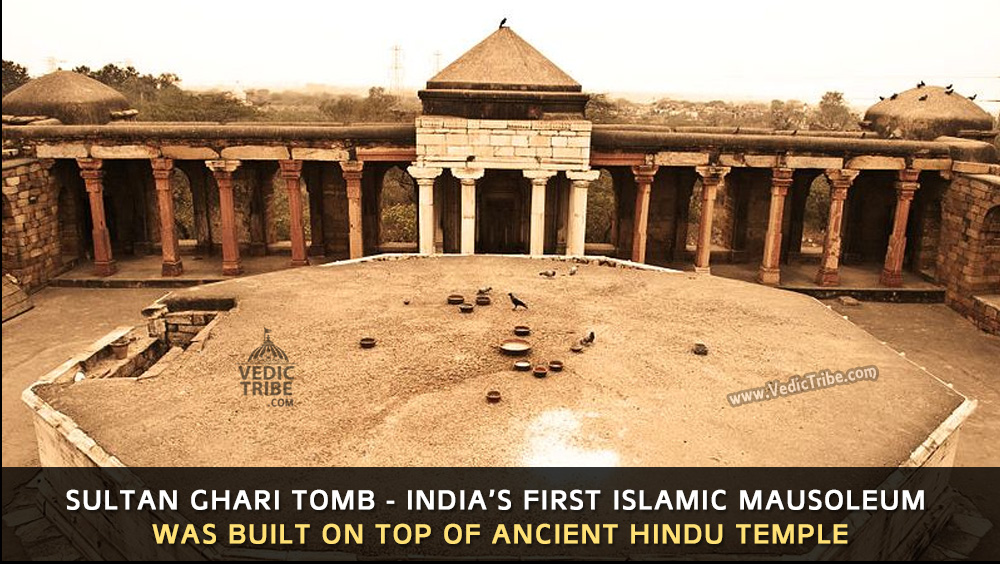
About 6 km west of Qutab Minar in Delhi, there lies a tomb called Sultan Ghari which is believed to be the final resting place of Prince Nasir’ud-Din Mahmud, the uncrowned eldest son of Sultan Shamsuddin Iltutmish of the Slave Dynasty built in 1231 AD. It was the first Islamic Mausoleum built in India.
However, engraved symbols of animals, Shiva Linga and the Sanskrit inscriptions on ceiling tell a different tale altogether. The beams of the octagonal crypt bear figures of Kamadhenu, the celestial cow and Varaha, the wild boar reincarnation of Lord Vishnu. These two animals were a royal Hindu insignia and considering the ideology of Islam against idols and the immense hatred towards pigs, it is very unlikely that such statues would adorn the inside of a Muslim tomb.
![]()
Iltutmish invaded eastern part of India in 1225 AD which resulted in signing of a treaty between him and Iwaz Khalji, the ruler of Eastern India. After a few successive battles, Prince Nasiru’d-Din Mahmud was appointed governor of Lakhnauti province who later merged the province of Oudh with Bengal and Bihar, gaining him the title of “Malik-us-Sharq” (King of the East) by his father.
The Prince was killed in 1229 AD after a very short rule of 18 months. Grieved by the death of his favourite son, Iltutmish commissioned the Sultan Ghari Tomb. After Iltutmish’s death in 1236, his daughter, Razia Sultana ruled the kingdom until her defeat and death in 1240 AD.
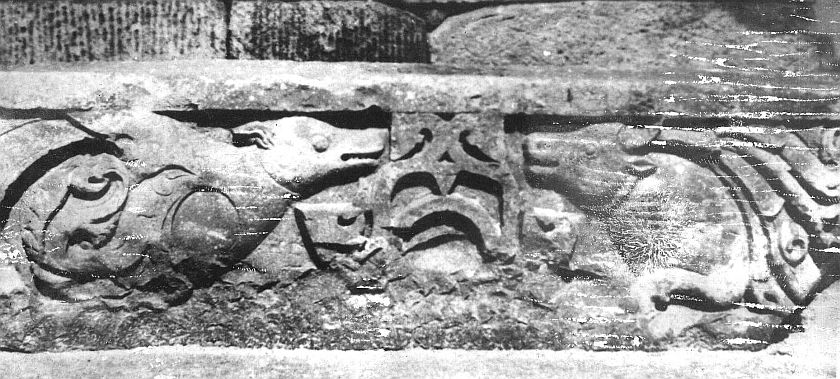
While ASI is pretty much silent on this matter, historians and archaeologists justify these carvings as new buildings being fashioned out of the debris of some Hindu buildings or that the workmen may have been Hindus and would have built the tomb in Hindu style. Their arguments in favor of the tomb fail here because no building worth its name can be build out of old debris and no workman would even dare to fashion a building for which he is hired according to his taste rather than that of the owner’s.
The building is also of an octagonal shape which is another Hindu specialty.
Due to indifference or perhaps purposeful negligence by the government and ASI, we may never know the reality and history of this ancient Hindu temple.

Follow us on Facebook
Follow us on Twitter
Latest


Seven Vows and Steps (pheras) of Hindu Wedding explained
Views: 6,403 Indian marriages are well renowned around the world for all the rituals and events forming part of the...


Sari or Saree is symbol of Indian feminism and culture
Views: 5,542 One of the most sensual attires of a woman in India is undoubtedly the sari. It is a...


Atithi Devo Bhava meaning in Hinduism and India
Views: 4,790 Atithi Devo Bhava, an ancient line taken from the Hindu scriptures and was originally coined to depict a visiting person whose...


Sanskrit Is More Than Just A Method To Communicate
Views: 4,004 -By Ojaswita Krishnaa Chaturvedi anskrit is the language of ancient India, the earliest compilation of sound, syllables and...


Significance of Baisakhi / Vaisakhi
Views: 4,924 Baiskhi is also spelled ‘Vaisakhi’, and is a vibrant Festival considered to be an extremely important festival in...


Navaratri: The Nine Divine Nights of Maa Durga!
Views: 5,975 – Shri Gyan Rajhans Navratri or the nine holy days are auspicious days of the lunar calendar according...


History of Vastu Shastra
Views: 8,411 Vastu Shastra (or short just Vastu) is the Indian science of space and architecture and how we may...


Significance of Bilva Leaf – Why is it dear to Lord shiva?
Views: 7,665 – Arun Gopinath Hindus believe that the knowledge of medicinal plants is older than history itself, that it...


Concept of Time and Creation (‘Brahma Srishti’) in Padma Purana
Views: 8,514 Pulastya Maha Muni affirmed to Bhishma that Brahma was Narayana Himself and that in reality he was Eternal....


Karma Yoga – Yog Through Selfless Actions
Views: 7,936 Karma Yoga is Meditation in Action: “Karma” means action and “yoga” means loving unity of our mind with...

